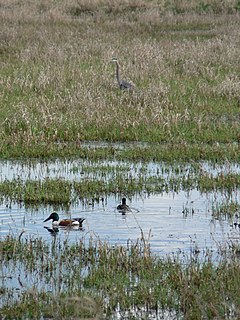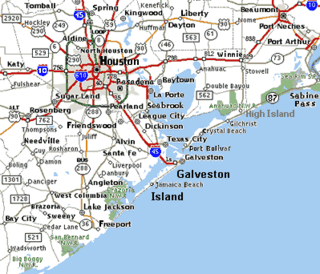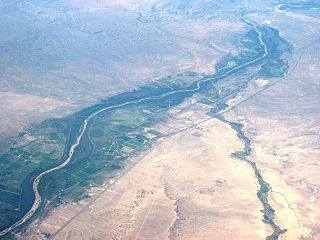Related Research Articles

Muleshoe National Wildlife Refuge is a 6,440-acre (26.1 km2) wildlife refuge located about 20 mi (32 km) south of Muleshoe, Texas, on Texas State Highway 214. It is the oldest national wildlife refuge in Texas, having been established as the Muleshoe Migratory Waterfowl Refuge by executive order of President Franklin D. Roosevelt in 1935. Roosevelt issued a proclamation in 1940 to change the name to the Muleshoe National Wildlife Refuge. In 1980, Muleshoe National Wildlife Refuge was designated as a National Natural Landmark by the National Park Service.

Ridgefield National Wildlife Refuge is a wildlife refuge, one of the national wildlife refuges operated by the United States Fish and Wildlife Service, located in the westernmost part of Clark County, Washington. The refuge protects more than 5,200 acres (2,100 ha) of marshes, grasslands, and woodlands. The refuge was established in 1965, in response to a need to establish vital winter habitat for wintering waterfowl with an emphasis on the dusky Canada goose whose nesting areas in Alaska were severely impacted by the violent earthquake of 1964. Ridgefield NWR is part of the Ridgefield National Wildlife Refuge Complex, headquartered in Ridgefield, Washington, which oversees the management of four refuges in the southwestern part of the state: Ridgefield, and three refuges in the Columbia River Gorge: Franz Lake, Pierce, and Steigerwald Lake. This place was closed in spring of 2019 to cut down Douglas fir and change the trail. In fall of 2020, the construction of a new multi-purpose building began. The new multi-purpose building will be a construction type V-B and consist of a 4,415 square foot single story building with an associated balcony and basement area. The building is being constructed to provide the fish and wildlife staff office space, meeting space, and an area for public visitors including volunteers and conservation partners.
The Tonawanda Wildlife Management Area is a 5,600-acre (23 km2) wildlife management area (WMA) located in western New York State. It is located primarily within Niagara County and Genesee County, with a small portion within Orleans County. It is managed by the New York State Department of Environmental Conservation.
Land's End Wildlife Management Area is a 462-acre (187 ha) Wildlife Management Area (WMA) in southeastern King George County, Virginia. The site is a mixture of open farmland, woodland, and wetland, and comprises two separate tracts: The 50-acre (20 ha) Salem Church Tract, and the 412-acre (167 ha) Land's End Tract. The area is bordered on two sides by the Rappahannock River and on one by Jett's Creek, and is primarily managed as a refuge for migrating waterfowl; Canada geese can often be seen in the winter feeding on fields of corn, milo, and winter wheat in the area, and resting in the nearby Nanzatico Bay. Among the other species often seen on the property are bald eagles, deer, wild turkey, and songbirds.
Powhatan Wildlife Management Area is a 4,462-acre (18.06 km2) Wildlife Management Area (WMA) in Powhatan County, Virginia. Consisting primarily of former farmland, much of the area is currently covered by open fields; these combine with mature and new forest growth to provide habitat for a diverse array of wildlife. The property is divided by Route 60 and contains one interior parcel of privately owned land. The elevation of the property is between 200 and 350 feet above sea level.

Dunkard Fork Wildlife Management Area is located on 470 acres (190 ha) in Marshall County near Moundsville, West Virginia. Mixed hardwoods cover most of the former Jacob Crow (1815-1901) (later C.C. Mooney [d. 1970] farm, site, whose major focus is a flood control lake on Dunkard Fork Wheeling Creek. The rolling terrain is punctuated with a few highwalls and ponds. Dunkard Fork WMA is located in northeast Marshall County along the Pennsylvania line on County Route 15. Construction of the dam was originally slated for a location upstream, but was later moved into West Virginia. Construction was underway by 1991 and the Jacob Crow farm was ruined. Archeological digs were conducted and photographs taken to document the site before the structures were razed.

The Brazoria National Wildlife Refuge is a 44,414-acre (179.74 km2) wildlife conservation area along the coast of Texas (USA), east of the towns of Angleton and Lake Jackson, Texas. It borders Christmas Bay and the Intracoastal Waterway, separated from the Gulf of Mexico by Follet's Island.

Frozen Camp Wildlife Management Area is located on 2,587 acres (1,047 ha) in Jackson County near Ripley, West Virginia. The hilly terrain is mostly covered with second-growth mixed hardwoods, with some open creek bottoms and ridgetops.

Black Pond Wildlife Management Area is a 526-acre (213 ha) New York State Wildlife Management Area (WMA) that lies on the eastern shore of Lake Ontario, and at the northern limit of an unusual region of sandy barrier beaches and lagoons. Much of the barrier beach in Black Pond WMA has forested sand dunes that are about 60 feet (18 m) high; these are the highest sand dunes in the northeast United States excepting Cape Cod. Immediately north of the WMA is the 360-acre (150 ha) El Dorado Beach Preserve, which is a bird refuge owned by The Nature Conservancy. North of the outlet from Black Pond to Lake Ontario, the shoreline is a weathered, flat bedrock shelf that is "calcareous" instead of sandy.

Upper Mud River Wildlife Management Area, is located about 12 miles (19 km) south of Hamlin, West Virginia in Lincoln County, U.S.A. Upper Mud River WMA is located on 1,425 acres (577 ha) of steeply forested terrain.

Woodrum Lake Wildlife Management Area, is located about 3 miles (4.8 km) east of Romance, West Virginia in Jackson County. Woodrum Lake WMA is located on 1,696 acres (686 ha) of hilly oak-hickory hardwood lots mixed with abandoned farmland.
The San Luis National Wildlife Refuge Complex is located in the northern San Joaquin Valley, within Merced County and Stanislaus County of California. The complex, with four federal National Wildlife Refuges, is managed by the U.S Fish & Wildlife Service.

Butte Sink Wildlife Management Area is located in Colusa, Butte, and Sutter Counties. It is wetlands managed as part of the Sacramento National Wildlife Refuge Complex and is not open to the public.
Pend Oreille Wildlife Management Area at 4,908 acres (19.86 km2) is an Idaho wildlife management area in Bonner County near Sandpoint. Much of the land that is now the WMA was licensed to the Idaho Department of Fish and Game by the U.S. Army Corps of Engineers in 1956 as mitigation for wildlife habitat impacted by the construction of Albeni Falls Dam. Additional land was purchased in 1974 and three more parcels were licensed in 1996. Acquisitions were completed in 1997 with funds from the Bonneville Power Administration.
Payette River Wildlife Management Area at 1,200 acres (4.9 km2) is an Idaho wildlife management area in Payette County near New Plymouth along the Payette River. Land was first purchased by the Idaho Department of Fish and Game in 1960.
Deer Parks Wildlife Management Area is a 2,556-acre (1,034 ha) Idaho wildlife management area in Madison County near the town of Roberts. Land in the WMA was acquired in 1997 and 1999 for partial mitigation of the effects of the construction of the Palisades Dam.

Bernardo is an unincorporated community in Socorro County, New Mexico, United States, at the northern junction of US 60 and Interstate 25. Bernardo was named, circa 1902, after a friend of John Becker, a leading merchant in nearby Belen. The main point of interest is the nearby Bernardo Wildlife Management Area, visited by large flocks of sandhill cranes and other birds.

The New Mexico Department of Game and Fish (NMDGF) is a state-level government department within the New Mexico Governor's Cabinet that is responsible for maintaining wildlife and fish in the state. The NMDGF undertakes protection, conservation and propagation, and regulates the use of game and fish to ensure there is an adequate supply for recreation and food.
The Valle de Oro National Wildlife Refuge is a protected area in New Mexico managed by the United States Fish and Wildlife Service as part of the National Wildlife Refuge System. It is located 7 miles (11 km) south of Albuquerque, New Mexico. This unit abuts the Rio Grande Valley State Park, which is adjacent to the Rio Grande.
Joyce Wildlife Management Area is a 34,520 acres (13,970 ha) protected area in Tangipahoa, Parish, Louisiana, owned by the Louisiana Department of Wildlife and Fisheries. It is located 10 miles (16 km) south of Hammond, Louisiana and features a boardwalk leading into the swamps on the northwest corner.
References
Citations
- ↑ Ausherman 2012, p. 285.
- 1 2 3 4 Ladd S. Gordon Waterfowl Complex - NMDGF.
- 1 2 Cartron, Lightfoot & Mygatt 2008, p. 3.
- ↑ Liddell & Hussey 2011, p. 143.
- ↑ Huey 1992.
- ↑ Graduate Scholarships.
- ↑ Crow 2000, p. 67.
- ↑ Blond, Dunford & Schulte-Peevers 2008, p. 282.
Sources
- Ausherman, Stephen (2012-02-14). 60 Hikes Within 60 Miles: Albuquerque: Including Santa Fe, Mount Taylor, and San Lorenzo Canyon. Menasha Ridge Press. p. 285. ISBN 978-0-89732-600-1 . Retrieved 2012-10-01.
- Blond, Becca; Dunford, Lisa; Schulte-Peevers, Andrea (2008-10-01). Southwest USA. Lonely Planet. ISBN 978-1-74104-713-4 . Retrieved 2012-10-01.
- Cartron, Jean-Luc E.; Lightfoot, David C.; Mygatt, Jane E. (2008-11-16). A Field Guide to the Plants and Animals of the Middle Rio Grande Bosque. UNM Press. ISBN 978-0-8263-4269-0 . Retrieved 2012-10-01.
- Crow, Melinda (2000-03-01). Camping New Mexico. Globe Pequot. ISBN 978-1-56044-709-2 . Retrieved 2012-10-01.
- "Graduate Scholarships" (PDF). NMSU College of Agricultural, Consumer and Environmental Sciences. Retrieved 2012-10-01.
- Huey, William S. (January–February 1992). "Ladd S. Gordon: My Best Friend". New Mexico Wildlife. Retrieved 2012-10-01.
- "Ladd S. Gordon Waterfowl Complex" (PDF). New Mexico Department of Game & Fish. Archived from the original (PDF) on 2013-03-22. Retrieved 2012-10-01.
- Liddell, Judith; Hussey, Barbara (2011-10-26). Birding Hot Spots of Central New Mexico. Texas A&M University Press. ISBN 978-1-60344-426-2 . Retrieved 2012-10-01.